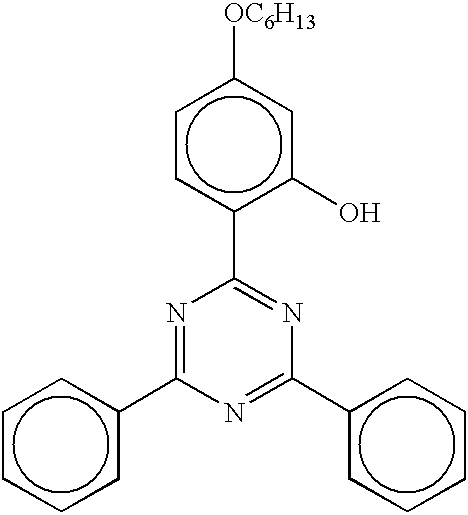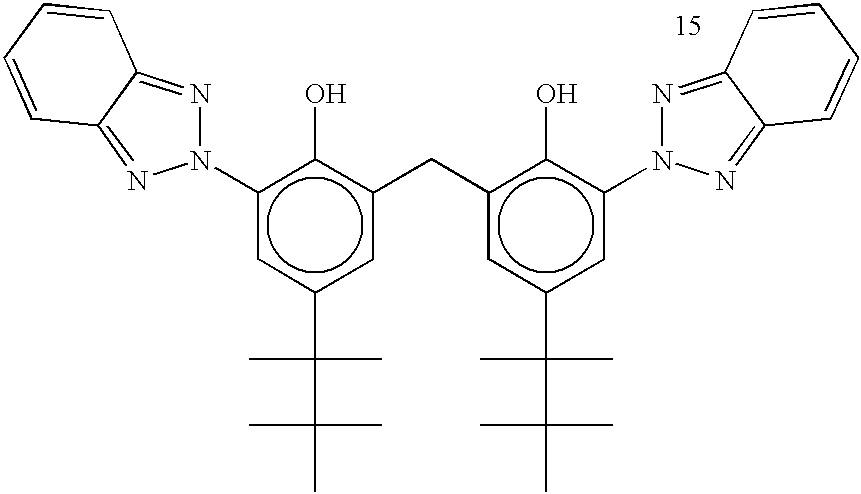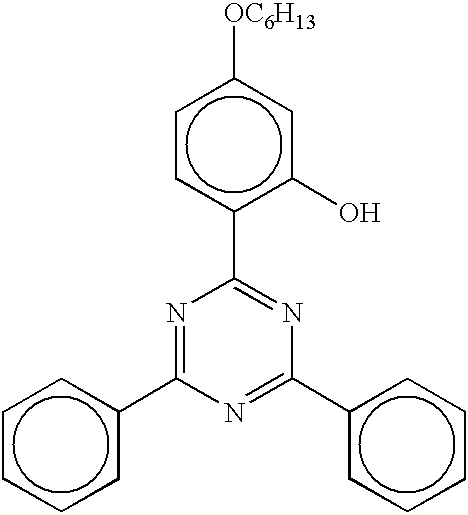White, UV-stabilized film made from a crystallizable thermoplastic
a technology of crystallization thermoplastics and stabilizers, which is applied in the direction of polyester coatings, applications, domestic applications, etc., can solve the problems of film yellowing and impairment of mechanical properties, no proposal can be found in this text, and neither films nor items produced from them are suitable for outdoor applications
- Summary
- Abstract
- Description
- Claims
- Application Information
AI Technical Summary
Benefits of technology
Problems solved by technology
Method used
Image
Examples
example 2
[0118] A white film is produced in a manner similar to that of Example 1. The UV stabilizer 2-(4,6-diphenyl-1,3,5-triazin-2-yl)-5-(hexyloxy)phenol (.RTM.Tinuvin 1577) is fed in the form of a masterbatch. The masterbatch is composed of 5% by weight of Tinuvin 1577 as active component and 95% by weight of the polyethylene terephthalate of Example 1.
[0119] Prior to extrusion, 90% by weight of the titanium-dioxide-containin-g polyethylene terephthalate of Example 1 are dried with 10% by weight of the masterbatch at 170.degree. C. Extrusion and film production are carried out in a manner similar to that of Example 1.
[0120] The white PET film produced has the following property profile:
4 Thickness 50 .mu.m Surface gloss, side 1 74 (Measurement angle 20.degree.) side 2 71 Luminous transmittance 27% Surface defects (fish-eyes, none orange peel, bubbles, etc.) Longitudinal mod. of elasticity 4200 N / mm.sup.2 Transverse mod. of elasticity 5650 N / mm.sup.2 Longitudinal tear resistance 160 N / mm.s...
example 3
[0122] A white film of 350 .mu.m thickness is produced in a manner similar to that of Example 2. The PET film produced has the following property profile:
6 Thickness 350 .mu.m Surface gloss, side 1 70 (Measurement angle 20.degree.) side 2 60 Luminous transmittance 10% Surface defects per m.sup.2 none (fish-eyes, orange peel, bubbles, etc.) Yellowness Index 50 Longitudinal mod. of elasticity 3600 N / mm.sup.2 Transverse mod. of elasticity 4200 N / mm.sup.2 Longitudinal tear resistance 180 N / mm.sup.2 Transverse tear resistance 200 N / mm.sup.2 Longitudinal elongation at break 220% Transverse elongation at break 190%
[0123] After 1000. hours of weathering per side with an Atlas Ci 65 Weather-Ometer the PET film has the following properties:
7 Thickness 350 .mu.m Surface gloss, side 1 68 (Measurement angle 20.degree.) side 2 65 Luminous transmittance 9% Surface defects (cracks, none embrittlement) Yellowness Index (YID) 52 Longitudinal mod. of elasticity 3500 N / mm.sup.2 Transverse mod. of elast...
example 4
[0124] Coextrusion technology is used to produce a multilayer PET film of 50 .mu.m thickness with the layer sequence A-B-A, where B is the core layer and A are the outer layers. The thickness of the core layer B is 48 .mu.m, and each of the two outer layers covering the core layer has a thickness of 1 .mu.m.
[0125] The titanium-dioxide-containing polyethylene terephthalate used for the core layer B is identical with that of Example 2. The polyethylene terephthalate of the outer layers A is identical with the polyethylene terephthalate of Example 2 except that no titanium dioxide is present.
[0126] The 5% strength by weight .RTM.Tinuvin 1577 masterbatch is used in a manner similar to that of Example 2, but 20% by weight of the masterbatch are fed, using masterbatch technology, only to the outer layers of 1 .mu.m thickness.
[0127] The white, multilayer PET film produced, UV-stabilized in the outer layers, has the following property profile:
8 Layer structure A-B-A Overall thickness 50 .mu...
PUM
| Property | Measurement | Unit |
|---|---|---|
| Fraction | aaaaa | aaaaa |
| Percent by mass | aaaaa | aaaaa |
| Percent by mass | aaaaa | aaaaa |
Abstract
Description
Claims
Application Information
 Login to View More
Login to View More - R&D
- Intellectual Property
- Life Sciences
- Materials
- Tech Scout
- Unparalleled Data Quality
- Higher Quality Content
- 60% Fewer Hallucinations
Browse by: Latest US Patents, China's latest patents, Technical Efficacy Thesaurus, Application Domain, Technology Topic, Popular Technical Reports.
© 2025 PatSnap. All rights reserved.Legal|Privacy policy|Modern Slavery Act Transparency Statement|Sitemap|About US| Contact US: help@patsnap.com



